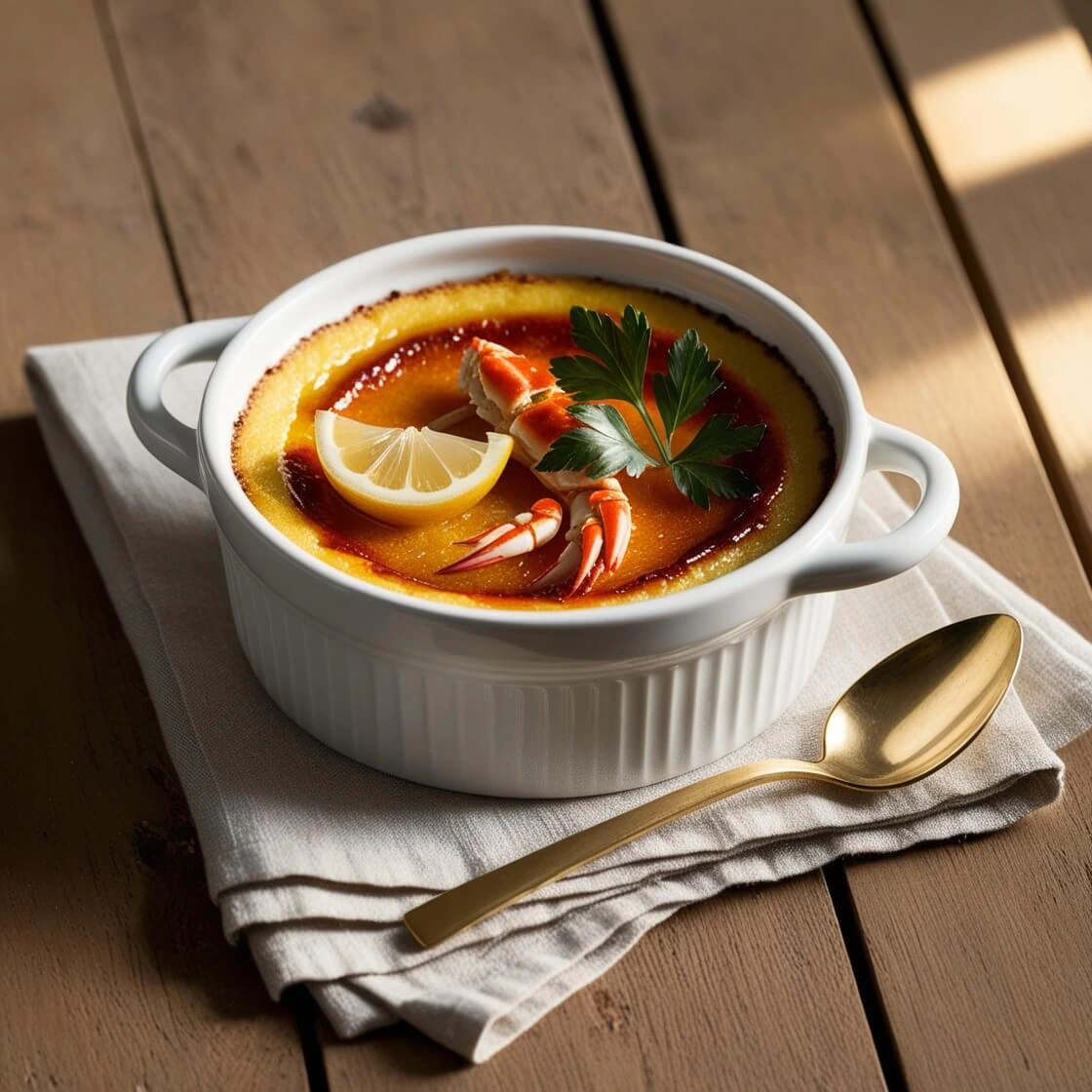Crab Brulee offers a sophisticated, savory take on the traditional crème brûlée. This delicious and elegant seafood dish is perfect for impressing guests at any dinner party or special occasion. In this blog post, we will guide you through the steps to create the perfect Crab Brulee recipe at home, using fresh crab meat and a few essential ingredients to achieve that crispy, caramelized top we all love.
What is Crab Brulee?
What Makes Crab Brulee Unique?
Crab Brulee takes inspiration from the traditional crème brûlée, which is typically a rich, sweet dessert. However, in this dish, the sweet custard is replaced with a savory crab mixture, making it an ideal choice for seafood lovers. The creamy base is enhanced with crab meat, herbs, and seasoning, and then topped with a crispy, caramelized sugar crust. The contrast between the rich custard and the crispy top is what makes this dish so unique and indulgent.
Difference Between Crab Brulee and Regular Crème Brûlée
While both dishes feature the same classic technique of creating a smooth custard with a crisp sugar topping, the key difference lies in the flavor profile. Crème brûlée is sweet, often flavored with vanilla or fruit, and served as a dessert. Crab Brulee, on the other hand, is savory, with rich crab meat, cream, and seasonings taking center stage. It’s a sophisticated appetizer or main dish that brings the elegant presentation of crème brûlée to the savory world.
History and Origins of Brulee Dishes
Crème brûlée is believed to have originated in France, with variations popping up in different regions. The dish itself was first recorded in the 17th century, and its name comes from the French word “brûler,” meaning “to burn,” referencing the process of caramelizing sugar on top of the custard. Over time, chefs began experimenting with different savory versions of this dish, including crab brulee, which blends the technique of making crème brûlée with the rich flavors of seafood.
Essential Ingredients for the Perfect Crab Brulee
To make the perfect crab brulee, it’s important to choose fresh ingredients. For premium crab meat, visit SeafoodSource. You can also find high-quality Parmesan cheese to elevate your dish.
Fresh Crab Meat Selection
When making crab brulee, the most important ingredient is, of course, the crab. You can use various types of crab meat, depending on what’s available and your preference. Dungeness crab is a popular choice for its sweet, delicate flavor, while King crab offers a more substantial texture. Blue crab also works well if you prefer a slightly sweeter, tender meat. It’s essential to use fresh crab meat, as canned versions may not offer the same delicate taste and texture that fresh crab provides. Be sure to remove any shells and cartilage before cooking.
Key Ingredients for a Rich Flavor
For the custard base, you’ll need heavy cream, egg yolks, and Parmesan cheese. The cream adds richness and smoothness, while the egg yolks help bind everything together and provide that velvety texture. Parmesan cheese adds a savory depth of flavor, complementing the sweetness of the crab. Shallots are an essential ingredient to add a mild, onion-like flavor that enhances the overall profile of the dish.
Choosing the Right Seasonings and Toppings
Seasoning is crucial in bringing out the best flavors in your crab brulee. A splash of white wine adds acidity and helps balance the richness of the cream and crab. Fresh herbs such as thyme, parsley, and tarragon are great choices to season the dish without overpowering the crab. For the brulee topping, you’ll need sugar, which caramelizes under heat to form the signature crispy layer. You can also use a bit of lemon zest for a refreshing citrus note.
Step-by-Step Guide to Making Crab Brulee at Home
Preparing the Crab and Cream Base
Start by preparing your fresh crab meat. Gently remove the crab meat from the shell, making sure to avoid any bits of shell or cartilage. Once your crab meat is ready, set it aside. In a saucepan, combine heavy cream, shallots, white wine, and a pinch of salt. Heat the mixture over medium heat until it begins to simmer, allowing the flavors to meld together. Once simmering, remove it from the heat and let it cool for a few minutes. In a separate bowl, whisk together egg yolks and Parmesan cheese until smooth.
Assembling and Baking the Crab Brulee
Now, it’s time to assemble your crab brulee. Preheat your oven to 325°F (165°C) and prepare individual ramekins. Spoon a generous amount of crab meat into each ramekin. Carefully pour the cooled cream mixture over the crab meat, filling the ramekins. Ensure the mixture covers the crab but doesn’t overflow. Place the ramekins in a baking dish and add hot water to the dish to create a water bath. Bake the crab brulees for about 30-35 minutes, or until the custard is set but still slightly wobbly in the center.
Achieving the Perfect Brulee Top
Once the crab brulees are baked and cool enough to handle, it’s time to achieve the signature crispy top. Sprinkle a thin, even layer of sugar over the custard. Use a kitchen torch to caramelize the sugar, moving the flame evenly across the surface until it turns golden brown and crispy. If you don’t have a torch, you can also broil the crab brulees in the oven for 1-2 minutes, keeping a close eye on them to prevent burning. The brulee should have a perfectly crisp, sweet topping with a smooth, savory custard beneath.
Tips for a Perfect Crab Brule
How to Avoid Common Mistakes
A few common mistakes can affect the texture and flavor of your crab brulee. First, avoid overcooking the custard. If it cooks too long, it can become rubbery or curdled. It’s also important not to overdo the crab meat, as too much crab can overpower the delicate custard. When making the brulee topping, be careful not to burn the sugar. The goal is to caramelize it, not turn it black.
How to Adjust Seasonings to Suit Your Taste
Taste is subjective, and you can always adjust the seasoning to suit your preference. If you like a more herby flavor, add extra fresh herbs like parsley or dill. For a more tangy profile, squeeze a bit of fresh lemon juice over the finished crab brulee. If you prefer a more savory brulee, consider using a dash of cayenne pepper or paprika to add a hint of heat.
Serving and Pairing Suggestions
Crab brulee is a rich and indulgent dish, so it pairs wonderfully with lighter sides. A crisp, refreshing salad with a lemon vinaigrette can provide a nice contrast to the richness of the crab. For wine pairings, go for a light white wine like Chardonnay or Sauvignon Blanc, which complements the seafood without overpowering it.
Why Crab Brulee is the Ultimate Seafood Dish for Special Occasions
Impress Your Guests with This Gourmet Dish
Crab brulee is the perfect dish for impressing guests at dinner parties or special celebrations. The unique combination of crab and the decadent custard makes it a show-stopping centerpiece at any meal. The presentation, with its golden, caramelized top and delicate seafood interior, is sure to wow anyone who tries it.
Perfect for Fine Dining and Celebrations
Crab brulee brings the sophistication of fine dining into your home. It’s an ideal dish for celebrations like holidays, anniversaries, or birthdays. The rich, luxurious flavors make it a treat that’s perfect for special occasions, ensuring a memorable dining experience for your guests.
Health Benefits of Crab Meat
In addition to being delicious, crab meat is also packed with health benefits. It’s a great source of lean protein and contains essential nutrients like omega-3 fatty acids, which are good for heart health. Crab also provides vitamins and minerals like zinc and vitamin B12, making it a nutritious addition to any meal.


